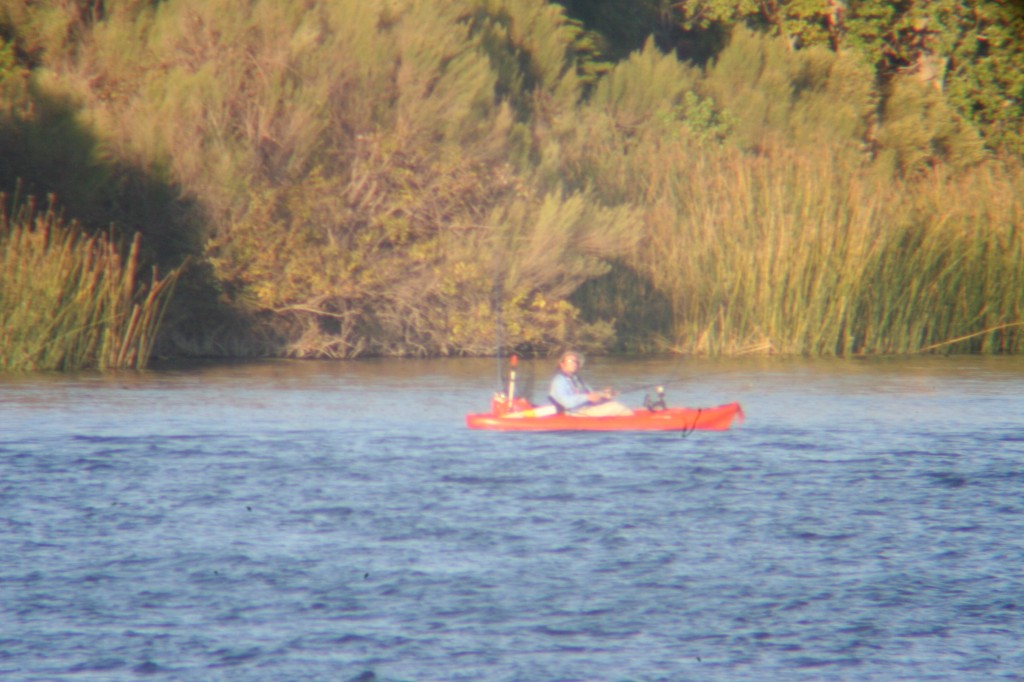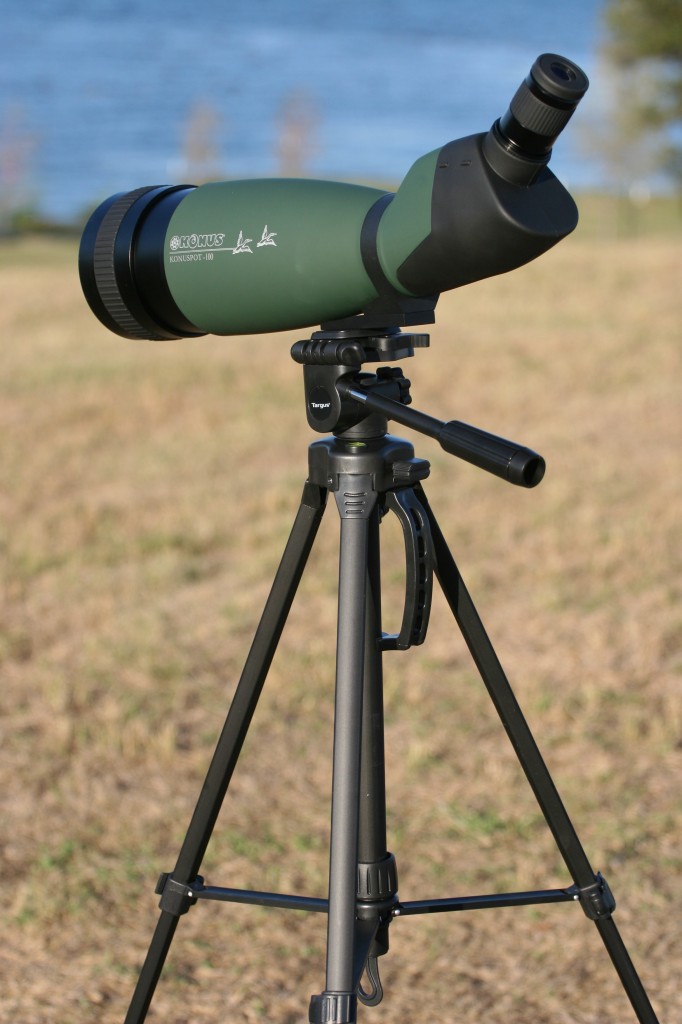Before you tear into this review, do me a favor and read the write-up I did on this beast’s little brother. You’ll want to be somewhat familiar with the highs and lows I had with the 70mm version because it is impossible to not compare the two.
Fit and Finish – * * *
Just like the 70, the 100 model is finished out quite nicely. All of the controls have a satisfying, solid feel and operate with a nice level of precision. The same rubber coating adorns the 100, too, and is just as easily cleaned up with a bit of Pledge or Windex.
The focus knob on the 100 works a tad better for me as it allows me to rest my palm on the body of the scope to manipulate the focus. This baby also has a convenient built-in sunshade that slides back and forth.
Unlike the 70, however, the 100 doesn’t come with a tripod so factor in the cost of a nice set of legs if you are considering the 100. And when I say nice, I mean nice. You’ll want something with a very solid mounting base. Your average Walmart special may be perfect for a run-of-the-mill SLR camera or even small spotting scopes, but it will fold under the pressure of this big boy optic.
If you’re shooting at less than 400 yards, rickety legs won’t affect your ability to spot much. But when you get out past that distance or run up the zoom factor, the flex from a bargain basement tripod will have you wishing your scope had some fancy image stabilization capability. And that you had a motion sickness patch behind your ear. If you’re a distance shooter, a few dollars more invested in a good pod is a lot less expensive than buying a scope with IS (or, in Nikon’s case, VR) technology.
Be forewarned that with the eyepiece removed, no amount of tightening on a tripod’s friction lock will keep the scope from tipping ass over teakettle. I nearly shattered the damn thing the first time I took off the eyepiece on mine. But you’ll have to remove the eyepiece regularly if you want to put it back in the included furry storage bag. It’s too small to fit with the 100’s ocular screwed in.
And that points out a major design flaw on Konus’ part – not moving the tripod mount to a more centrally balanced location. Also why not provide a bag big enough to hold both the scope and objective lens? I already have dirt and crud in the scope now from having to remove the objective each time I want to stow it away.
Clarity – * * *

I found after a few hours of use that I was using the 70 more when I needed to pick out greater detail. I can’t quite pin it down, but the 100 seems to have just a touch of graininess and loss of contrast at high zoom factors and greater distances. My photographer buddy thought that it had a bit of a purple tinge as well. I wasn’t really able to pick it up, though, as my rods and cones are pretty much worthless. But put me in a low-light situation in the early morning or late evening and I’ll still take the 100 in a heartbeat. There’s definitely something to be said for having 100mm of light gathering power.
Accessories – * * * *
You get all the same accessories as the 70 minus the tripod. The same T adapter that you bought for the 70 will work with the 100, too.
Moving and Grooving – * * *
Quite simply, screw walking around with this thing and a gun. You’ll have to pick one or the other. Not only is it ungodly heavy, its bulky as well. If I was traipsing off to the woods with my gun and some overnight gear, this scope would make it about 100 yards into the woods before being left by a tree.
Overall Rating – * * *
This is a nice optic. However, it is not a “woods” scope by any means. You’ll only be lugging this bastard from the truck to the range along with a really manly tripod. For about the same money, you could have the 70 and a nice tripod. Given the choice between the two, the 70 is my pick.
Specifications: KonusSpot 20 – 60X x 100 mm Spotting Scope
- Magnification: 20-60X
- Objective Diameter: 100 mm
- Eyepiece Angle: 45 degree angled
- Eyepiece Type: zoom – removable
- Coatings: Multicoated
- FOV @ 1000 yards: 99.5 ft @ 20X; 51.3 ft at 60X
- Eye Relief: 18mm at 20X; 12 mm at 60X
- Waterproofing: Yes
- Length: 19.2”
- Weight: 85.7 oz
- Warranty: 1 year
- MSRP: $399.99 – Street value – $329.99 @ Optics Planet







Tyler, you said, “I already have dirt and crud in the scope now from having to remove the objective each time I want to stow it away.”. The objective lens is the lens nearest the “object” being observed, and away from the one using the scope. The ocular lens is the one that get’s removed on the spotting scope.
Editing error…my fault. Text is updated.
Does the $399/$329 include the eyepiece?
Yes, the eyepiece is included.
It does. My bad for not clarifying.
Motion sickness on the sea can result from being in the berth of a rolling boat without being able to see the horizon. Sudden jerky movements tend to be worse for provoking motion sickness than slower smooth ones, because they disrupt the fluid balance more.::-^
Check you later <http://www.healthmedicinebook.com
February 2014
Being the proud owner of the Konus 100 and having a ” Challenging Moment ” in finding the correct tripod I finally found ” IT “. The ” It ” being an affordable $ 150 range Sunpak M3 Pro Model with fliud head
tipod that supports up to 22 lbs of camera and gear.
We shoot long range rilfe out to 1050 yds in Central Texas, in conditions only Yankees would appreciate
We do have videos posted on You Tube showing how much difficulty we had in trying to manually focus our cameras with cheap ( under $ 100 ) tripods. Do your selves a favor and if you buy quality optics then buy a quality tripod to go with it as well.
You Tube video link : http://www.youtube.com/watch?v=yxT9YlUOTeo
How do you think the Konuspot 80 fits in?
/Evert
Hello:
I also own the 100mm monster. It is heavy, bulky and hard to put it on the tripod, but it gives a sharp view for my purpose. I bought it mainly to photograph the planets and moon, and occasionally shooting wild life at a distance. The issue that I am facing is the focusing while the camera is attached with the scope. I am using Canon T6 camera, with T-Ring and the adapter that comes with the scope. When camera is attached, I am unable to focus the image. At best the images are blurry. Without the camera, the scope’s focus works fine.
Can anyone out there help? Do I need to purchase additional accessories for the focus to work?
Thank you.